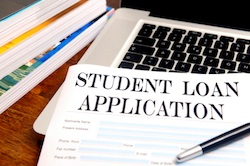The cost of college is growing faster than inflation, and now many students find it difficult to go to college without some type of loan financing.
To illustrate this, Heather Boushey, economist for the Center for Economic and Policy Research explains, “In 1981, a student could work full time all summer at minimum wage and earn about two-thirds of annual college costs. Today, a student earning minimum wage would have to work full time for a year to afford one year of education at a four-year public university–and that assumes she saves every penny” (USA Today).
According to FinAid.org, “Two-thirds (65.6%) of 4-year undergraduate students graduated with a Bachelor’s degree and some debt in 2007-08.”
While the vast majority of those student loans are federal student loans, a small portion of them are private student loans.
Getting in student loan debt too deeply is a risk for all students, but private loans in particular come with inherent risks.
Before you sign on the dotted line, make sure you know what you are getting yourself into.
The Benefits of Private Student Loans
Private student loans help fill a gap for many students from what they qualify for in federal financial aid (including federal student loans) and what they can actually pay. Besides serving as a bridge, private student loans have a few other benefits:
1. There is no need to fill out a FAFSA.
People qualify for private student loans based on their credit score and history, not a FAFSA (Free Application for Federal Student Aid). In fact, there is no need to fill out a FAFSA, which some people may prefer.
2. Payment is deferred until after graduation.
Students do not need to begin paying on their private student loans until after they graduate or leave school, whichever comes sooner.
The Drawbacks of Private Student Loans

1. Private student loans have a variable interest rate.
Unlike federal student loans where the rate is fixed through the life of the loan, private student loans have a variable interest rate. The interest rate can climb and leave borrowers with a payment they cannot afford on their salary.
2. Deferment and forgiveness rules are much stricter.
Federal student loans offer deferment if the borrower goes back to school or if they have an income hardship. There are also several programs that can lead to loan forgiveness based on the borrower’s job and if they serve in a low income area for a certain number of years.
These options are largely unavailable for private student loans.
3. Inflexible repayment options.
Federal student loans offer students a number of different repayment plans including one based on the borrower’s income (income contingent), one based on the theory that the borrower will make more money as the years go on and can therefore pay a little more every two years (graduated), and a standard 10 year repayment plan.
Private student loans generally don’t offer such flexibility. Borrowers have one payment plan you must follow.
4. Cosigners are still responsible if you die.
Although most college students don’t die young, if they do, their parents must still repay the loan if they were the cosigner. This was recently brought to light when Ella Edwards, 61, mother of Jermaine Edwards, tried to start an online petition to demand that she not be responsible for repayment of her deceased son’s private student loans. (The federal government forgave Edward’s federal student loans when he passed away just a few years after graduation.)
Financial planners have gone so far as to suggest that if parents cosign private student loans for their college age students, they should make sure that the students have enough life insurance coverage to cover the amount borrowed. In the unlikely event that the student passes away, the parents won’t have to continue paying as Ella Edwards does. Instead, the life insurance policy would cover the remaining balance on the loan.
Finally
The problem of private student loans has gotten so bad that two senators, Dick Durbin and Tom Hawkin, are introducing The Know Before You Owe Act to educate students and their parents about the realities of private student loans.
Private student loans can fill in financial aid gaps for students, but it may be better to consider a college the student can afford without private loans.
Other options are available also such as going to a community college first to cut costs or working at the university to help pay college expenses. While students may not feel like they are having as much fun as other students at college, they will be glad to not have the private student loan monkey on their back when they graduate.
I cosigned student lines of credit for my sons. I am lower income and cannot help them very much. We are in Canada so there are lower interest government loans that they have both qualified for but it just wasn’t enough.
If they default on the lines of credit then I will be stuck with them and that would sink me in to hole I could never get out of but I am confident that I have raised responsible sons who would not leave me in the lurch.
Don’t tell Suze Orman. She does not approve of cosigning for anyone.
I have one private student loan and the interest rate has always been below what my federal student loans are at. I am happy for that! And this loan is gone thankfully.
That’s terrible, It’s bad enough that her child died, but now she has an $800 monthly reminder of his death. People should definitely try to get as many grants and scholarships as possible, that way they won’t need to take out a private student loan.